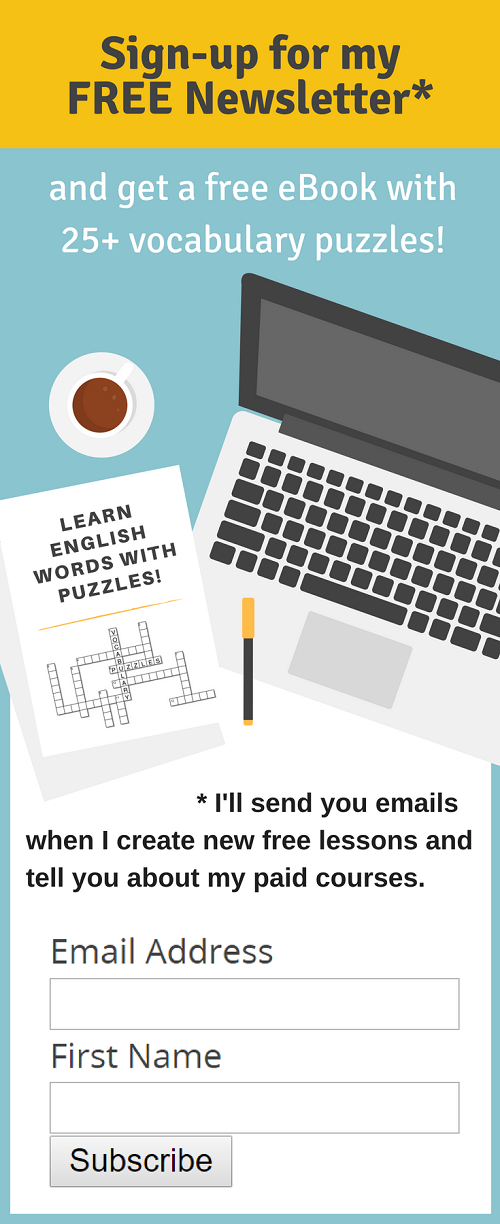Learn English Videos:
7 strategies to use videos to improve your English
If you want to learn English videos are a really great way to learn and practice. There are many different videos to choose from including regular videos made for English speakers and special videos designed for English language learners.

So many videos, so little time?
There are so many websites that offer great video lessons. You could spend the rest of your life watching them. This can actually be overwhelming and even frustrating.
More is not necessarily better.
This can be a problem for some English learners who watch video after video but they don't see significant improvements in their English. Some learners understand the main idea of a video but they don't learn the new vocabulary, slang and expressions the hear in the video. The speakers in the video probably use proper stress, rhythm and pronunciation but the learner doesn't notice these things when watching the video.
Here are seven tips that will help you use videos more effectively to learn English. You may also want to look at these three organizations that create videos that I believe are really helpful for English language learners.
Learn English video strategies
to help you improve your English
Learn English videos strategy #1: Repetition
Excuse me, could you repeat that please? I'm sorry, I didn't understand, could you say that again more slowly? I can't understand you, could you please write that down?
Repeat, repeat, repeat.
Language learners usually have to ask people to repeat new things they hear several times in order to understand everything. It's the same with videos, even if it doesn't seem that way. My first tip is to watch the same video several times and on different days.
When you watch a video the first time, you focus on the overall meaning. This is great but there's so much more to learn! Watch the video the second time and you might here new words. Watch the video a third time and you might notice a new idiom. Watch the video a fourth time with captions and you might remember the new word or expression when you hear it again another time.
After you understand the main point of a video, it’s easier to focus on other things like listening to pronunciation, intonation and stress or learning new vocabulary and idioms. Repetition and exposure are keys to language learning. It can be very helpful to watch the same video a few days or even weeks apart.
I highly recommend you hit the repeat button several times. You will be amazed how many times you can listen to the same video and learn new things.
Learn English videos strategy #2: Keep a notebook of new words to learn vocabulary
Researchers have done numerous studies to understand how many times a learner must see / read / hear) a new word in context in order to learn it.
They think it’s somewhere between 5-16 times.
Whatever the number, we have all had problems remembering words that we’ve seen before. I encourage my students to write new words and idiomatic expressions in a notebook and review them at the end of each week.
Writing a word down and using it in a new sentence can definitely help you memorize the meaning or at least be able to recognize its meaning the next time you read or hear it in a new context.
Active learning (using the language you are learning in your own original writing and speaking efforts) can really help you learn more quickly than simply reading and listening to someone else’s English. Give it a try and see if it works for you.
Learn English videos strategy #3: Read the transcript out loud to improve pronunciation
Many websites that offer videos also provide the transcripts. Transcripts are not only great for listening, but you can use them to improve your own pronunciation.
Print out the transcript or watch the video with subtitles.
A good way to practice is to listen to 1-3 sentences and then pause the video and repeat what you have heard out loud.
If you are listening to a mother-tongue English speaker, pay attention to the pronunciation of words as well as the speaker’s tone, pitch, stress and rhythm.
It’s a great way to practice without spending money on products that offer fancy speech-recognition features. Many mobile phones have voice memo features which you can use to record yourself reading. Listening to your own recorded pronunciation can be an ear-opening experience!
Learn English videos strategy #4: Listening practice - Print transcripts and create your own gap fill exercises
As noted above, many of the organizations that create videos also provide transcripts of the audio recording. You can make your own “gap fill” exercises by printing out the transcript and covering some of the words.
- Just randomly cover some words by using correction tape/fluid or cut post-it note sticky paper in small pieces and cover the words.
- Then listen to the video and fill in the missing words. It’s great for listening. You will help train your ear to hear individual words.
I often create gap fill exercises for my blog lessons. Click here for an example gap fill exercise.
Learn English videos strategy #5: Focus on a specific topical area - Find related materials to build skills
It can be very helpful to select a particular topical area to focus on for a period of time. For example, select something you are interested in—it might be a particular travel destination, sport, celebrity, hobby, or so on—and find a video or two to watch several times.
In addition, find related materials on the same topic. You could find some articles to read or brochures and/or listen to interviews, music or podcasts depending on the topic. If you stay focused on one particular topic, it is likely that you will see the same vocabulary and expressions repeated in different ways. It helps with reading and listening too because you are already familiar with the topic.
Learn English videos strategy #6: Join in the discussions - write your own opinion about a video
Too many students spend most of their time learning passively. That is, they spend most of their time on receiving information in English—by reading and listening—rather than creating their own English (speaking and writing).
It is much easier to interpret what someone else has produced than it is to create your own English. For example, when you are watching a video, you get many cues (e.g., facial expressions, hand gestures, tone of voice) so if you don't know some of the words you may still understand what's being said.
But when you have to write in English by yourself you need to consider grammar, find the right words and put them together to express your idea. When speaking, you also have to learn pronunciation and get the right tone, stress and pitch.
With all of these things, it's highly likely you'll make at least one mistake. And that's exactly why learners usually don't write or speak... they're afraid of making mistakes! This is just part of the learning process. The sooner you can accept that, the faster your language skills will improve.
I recommend that you regularly practice your speaking and writing, even if it is just writing on your own or speaking to yourself at home.
I try to offer my visitors a chance to speak and write through this website too. Check out my TED Tuesdays lessons where you can leave comments to practice your writing and speaking skills.
As you can see, videos offer a great way for you to improve your English language skills. I hope that some of these resources and tips will be of use to you. All the best with your language studies!
P.S. Don’t forget to have some fun too!
Return from Learn English videos strategies to main videos page or to homepage.

